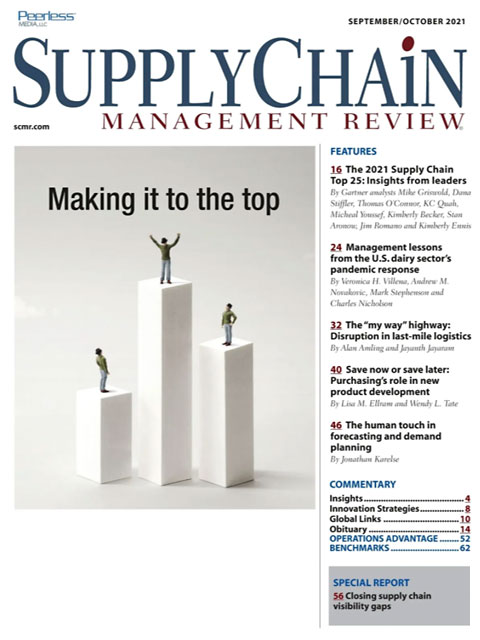Sorry, but your login has failed. Please recheck your login information and resubmit. If your subscription has expired, renew here.
September-October 2021
This time every year, we publish Gartner’s Top 25 supply chains, the annual list of the supply chains that have made it to the top, a list that now also includes 5 Masters, or companies that have consistently outperformed year after year. You can read the article in this issue, along with the web exclusive material we publish on scmr.com, to find out what it takes to become a supply chain leader. Browse this issue archive.Need Help? Contact customer service 847-559-7581 More options
Andrew Grove’s quote is nearly a quarter century old, but it could have been written today. The COVID-19 pandemic was one of those strategic inflection points for e-commerce supply chains. Fundamental changes occurred in supplier offerings and consumer preferences during this challenging time. Such structural changes cannot be addressed by continuing to do what we did before, but trying to do it better, faster and cheaper. Instead, they shift the boundaries that decisions are based on, and make new things not only possible but necessary. Whether these changes are a threat or an opportunity depends on the actions taken by supply chain leaders and challengers.
We have identified five trends that are driving the e-commerce supply chain inflection point.
- (Accelerating) rise of e-commerce
- Rise of the retailer logistician
- Rise of same-day/next-day delivery
- Rise of the data scientist
- Rise of robotics, automation and autonomy
They’re not new: Most companies doing e-business were already grappling with them before the spring of 2020. But the trends accelerated the change; what might normally have taken five years to unfold, happened in five months during the pandemic.
When new trends in the market are small, they can be ignored. When those trends move from niche to mainstream, ignoring them becomes a death sentence.
While the five trends mentioned above don’t necessarily signal the end of traditional supply chain networks, and they do have an effect on all aspects of supply chain management, our analysis speaks directly to the growth of e-commerce supply chains. Let’s look at each in more detail.
Trend#1: Rapid rise of e-commerce
While consumer demands have been skyrocketing since the mid-’90s, the COVID-19 pandemic put these demands on steroids. Millions of consumers purchased groceries online, used curbside pickup and shopped for holiday gifts online. This growth shows no signs of abating. In fact, FTI Consulting predicts that U.S. e-commerce retail sales will reach $1 trillion by 2023, and total e-commerce market share is projected to reach 27% by 2025 and 33% by 2030.

This complete article is available to subscribers only.
Log in now for full access or start your PLUS+ subscription for instant access.
SC
MR
Sorry, but your login has failed. Please recheck your login information and resubmit. If your subscription has expired, renew here.
September-October 2021
This time every year, we publish Gartner’s Top 25 supply chains, the annual list of the supply chains that have made it to the top, a list that now also includes 5 Masters, or companies that have consistently… Browse this issue archive. Access your online digital edition. Download a PDF file of the September-October 2021 issue.Andrew Grove’s quote is nearly a quarter century old, but it could have been written today. The COVID-19 pandemic was one of those strategic inflection points for e-commerce supply chains. Fundamental changes occurred in supplier offerings and consumer preferences during this challenging time. Such structural changes cannot be addressed by continuing to do what we did before, but trying to do it better, faster and cheaper. Instead, they shift the boundaries that decisions are based on, and make new things not only possible but necessary. Whether these changes are a threat or an opportunity depends on the actions taken by supply chain leaders and challengers.
We have identified five trends that are driving the e-commerce supply chain inflection point.
- (Accelerating) rise of e-commerce
- Rise of the retailer logistician
- Rise of same-day/next-day delivery
- Rise of the data scientist
- Rise of robotics, automation and autonomy
They’re not new: Most companies doing e-business were already grappling with them before the spring of 2020. But the trends accelerated the change; what might normally have taken five years to unfold, happened in five months during the pandemic.
When new trends in the market are small, they can be ignored. When those trends move from niche to mainstream, ignoring them becomes a death sentence.
While the five trends mentioned above don’t necessarily signal the end of traditional supply chain networks, and they do have an effect on all aspects of supply chain management, our analysis speaks directly to the growth of e-commerce supply chains. Let’s look at each in more detail.
Trend#1: Rapid rise of e-commerce
While consumer demands have been skyrocketing since the mid-’90s, the COVID-19 pandemic put these demands on steroids. Millions of consumers purchased groceries online, used curbside pickup and shopped for holiday gifts online. This growth shows no signs of abating. In fact, FTI Consulting predicts that U.S. e-commerce retail sales will reach $1 trillion by 2023, and total e-commerce market share is projected to reach 27% by 2025 and 33% by 2030.
SC
MR


More 3PL
- Orchestration: The Future of Supply Chain
- February and year-to-date U.S. import volume is solid, reports S&P Global Market Intelligence
- 2024 retail sales forecast calls for growth, says National Retail Federation
- ISM reports another month of services sector growth in February
- February manufacturing output declines, notes ISM
- How to Create Real Retailer-Brand Loyalty
- More 3PL
Latest Podcast

 Explore
Explore
Topics
Business Management News
- Survey reveals strategies for addressing supply chain, logistics labor shortages
- How CPG brands can deliver on supplier diversity promises
- How S&OP provides the answer to in-demand products
- AI, virtual reality is bringing experiential learning into the modern age
- Tips for CIOs to overcome technology talent acquisition troubles
- There is still work to do to achieve supply chain stability
- More Business Management
Latest Business Management Resources

Subscribe

Supply Chain Management Review delivers the best industry content.

Editors’ Picks






